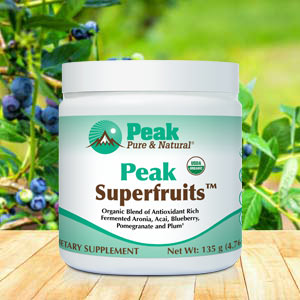Get Easy Health Digest™ in your inbox and don’t miss a thing when you subscribe today. Plus, get the free bonus report, Mother Nature’s Tips, Tricks and Remedies for Cholesterol, Blood Pressure & Blood Sugar as my way of saying welcome to the community!
Foods that lead to premature aging and the best that beat it

Anti-aging and longevity are both exciting and popular fields of research.
In just the last few years, discoveries regarding telomeres and mitochondria have provided big clues into how to live longer healthier.
But in my group of friends, I get asked about another kind of anti-aging quite often. The kind everyone wants to know how to drastically slow…
The kind that shows on your face and skin.
If I had a dime for every time someone, who knows I’m a health researcher/writer, asked for my advice on how to keep the wrinkles away and the skin from sagging, I’d be a billionaire. So after at least a decade of time spent researching just about everything, let me share what I’ve found… and what I put to work myself.
‘Anti-aging’ your skin
First, let’s talk about anti-aging products.
There are tons of them out there. And they can be quite pricey. But you should never assume the higher the price — the better the results… or even that you’ll ever get your money’s worth.
Companies selling anti-aging creams, lotions and serums will say just about anything to get you to buy them. And you should know that the U.S. Food and Drug Administration doesn’t require companies to prove their cosmetics do what they claim — or even that they are safe.
Most of them claim to essentially work miracles, but dermatologists and scientists will disagree.
Sure, it’s possible to temporarily make skin look as if it is healthy and glowing and plump with moisturizer. But deep down, they say not much else is happening. Topical products are just that. They might work on the surface, but they’re not making the layers of skin coming up any younger.
That’s why I’m here to explain why the most realistic way to decrease the look of aging on the outside, starts with what you put in the inside. And a lot of documented research agrees…
Foods that age you
Some foods lead to the creation of advanced glycation end products — also appropriately known as AGEs — in your body.
AGEs are non-enzymatic modifications of proteins or lipids after exposure to sugars. That’s some scientific jargon to explain how sugar (and oxidative stress in this case as well) damages your biological makeup… including your organs.
Most of that damage you can’t see, except when it becomes visible on your body’s biggest organ — your skin. The glycation process leads to a loss of protein function that impairs elasticity of not only your tendons and blood vessel tissue but also your skin.
And, because AGEs deactivate your body’s natural antioxidant enzymes, they leave you more vulnerable to another major cause of aging — sun damage.
Human and animal studies have removed any doubt that AGEs are harmful to the natural aging process. But what can you do to slow down their effect?
The first step is cutting down on sugar in your diet. The average American consumes way too much, so if you think that might be you, start cutting out the sweets. Cut down on the sugar you add to coffee or tea. And start reading labels. It’s insane how sugar is hidden in food these days.
Watch your consumption of meat and how you cook it. AGEs are naturally present in uncooked meat and certain cooking techniques form additional AGEs in those foods. Be wary of grilling, broiling, roasting, searing and frying. You can cut down somewhat on AGE formation by cooking with moist heat, shorter cooking times, lower temperatures and by using acidic ingredients like lemon juice or vinegar.
But just like there are foods that promote AGEs you should eat less of, researchers have also concluded that AGE formation and accumulation in your skin tissues can be inhibited by foods you want to eat more of…
Nutrients with the most anti-aging credibility
Research from the Journal of Exercise, Nutrition & Biochemistry indicates that foods that are polyphenols are capable of preventing the glycation process. Among polyphenols, you’ll find medicinal herbs, dietary plants, and phytocompounds.
The reason they work is due to their high antioxidant capacity. Among the best food sources of polyphenols are:
Spices: Cloves, star anise, capers, curry powder, ginger, cumin and cinnamon. Spices and herbs are very concentrated, so don’t use them sparingly. Apply these liberally, even in foods where you may not taste them, like smoothies.
Dried herbs: Peppermint, oregano, sage, rosemary, thyme, basil, lemon verbena, parsley and marjoram.
Drinks: Cocoa (but not the “swiss miss” packets — get real cocoa), green tea, black tea and red wine.
Dark berries: Black chokeberry, black elderberry, low bush blueberry, plum, cherry, blackcurrant, blackberry, strawberry, raspberry, prune, black grapes.
Seeds: Flaxseed and celery seeds.
Nuts: Chestnuts, hazelnuts, pecans, almonds and walnuts.
Olives: Black olives and green olives.
Vegetables: Globe artichokes, red chicory, green chicory, red onion, spinach, broccoli, curly endive.
Fruit other than berries: Apples, apple juice, pomegranate juice, peach, blood orange juice, lemon juice, apricot, quince. Now, a juice with added sugars would negate the anti-AGEs benefits of these foods.
Oils: Extra-virgin olive oil, rapeseed (canola) oil
What exercise does for an aging face
The same research has shown that exercise may be a powerful weapon against AGE formation and AGE-related aging.
For starters, exercise improves your antioxidant activity. Some antioxidants are taken into the body in foods, and some — like your master antioxidant, glutathione — is naturally produced by your body but declines with age.
Exercise can help you get them all working better for you. In fact, you can read what McMaster University found about exercise to get younger skin, here. If you can’t exercise for any reason, resveratrol, a terrific antioxidant on its own, helps your body upregulate glutathione.
Avoid extremes that age you
Sleep: Inadequate sleep not only makes it hard to function the next day, but if you sleep poorly regularly you could end up with a 45 percent increase in wrinkles, according to a study at the Sleep School of London. Sleep at least 8 hours a night for smoother skin.
Sun: Sun is enemy number one when it comes to accelerating the aging process. Spend short amounts of time in the sun to benefit from vitamin D, but it’s always a good idea to keep your face covered. I prefer a hat to toxic sunscreen lotions.
Inflammaging: This term refers to inflammation in the body and its impact on aging. Douse it with omega-3s, the fatty nutrient that can take years off your face. Not only can omega-3s eradicate inflammation, but they can also protect your skin from the effects of photo-aging that accumulates from a lifetime of sun exposure. Studies have shown that people who supplement with omega-3s experience less sun damage and have reduced signs of aging compared with those who don’t.
Editor’s note: Did you know that when you take your body from acid to alkaline you can boost your energy, lose weight, soothe digestion, avoid illness and achieve wellness? Click here to discover The Alkaline Secret to Ultimate Vitality and revive your life today!
Sources:
The role of glycation in the pathogenesis of aging and its prevention through herbal products and physical exercise — Journal of Exercise Nutrition & Biochemistry
Advanced Glycation End Products in Foods and a Practical Guide to Their Reduction in the Diet — Journal of the American Dietetic Association
Top 100 polyphenols. What are they and why are they important? — Catherine Saxelby’s Foodwatch













